Native Son: February 2015
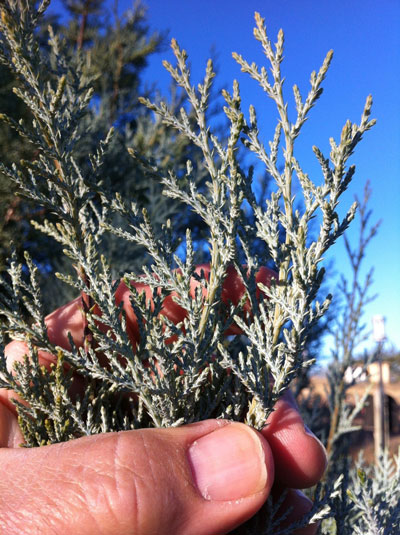
The silvery foliage of alligator juniper has a refreshing citrus-conifer scent. Photos courtesy of Steven Chamblee.
by Steven Chamblee
Alligator Juniper
When I was a boy, someone told me that beavers and humans were the only animals that change their environment to serve their own needs. True? I don’t know … elephants knock down trees, bison create wallows, ants and termites literally change the soil profile. Perhaps every creature, every plant, every insect changes the Earth a little, in a way that is imperceptible to most of us.
Gardeners spend their lives changing the environment, and most of the time we consider this a good thing. Personally, I’ve planted lots of trees — hundreds, maybe a thousand, I don’t know. But each time I did it, I said a little prayer or consecration that it would bring joy to people and a little goodness to the Earth.
Today I was admiring the row of alligator junipers (Juniperus deppeana) that my son and I planted about five years ago, and I thought about how they connect me to my past and my future. I first noticed this beautiful species a few decades back when I was up on Schnebly Hill on the outskirts of Sedona, Arizona.
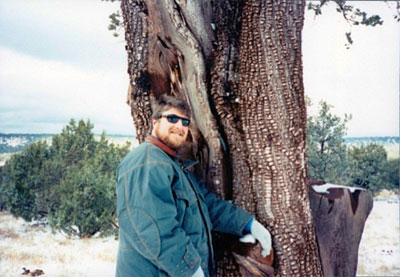
Steven poses with a mature alligator juniper tree just outside Sedona, Arizona. Note the characteristic “alligator hide” bark pattern. (1997)
I was wandering the blue lane highways out West and happened upon the town after swooshing down Slide Rock a few miles away. The checkered pattern of the bark caught my eye, and I was mesmerized at the thought that something could create such a mystical pattern out of dead plant cells. Once I took notice, I saw them everywhere … in the gullies, on the hillsides, growing out of cracks in the giant red rock cliffs. Most of them were 25 to 35 feet tall, though there was a 60-footer every so often. Most had dark green foliage, but some had a bluish tinge to the scaly leaves that made them look kind of frosted. I felt like I had discovered a treasure that lay hidden in plain sight. Indiana Chamblee….

When young and growing vigorously, alligator juniper features bark in a constant state of flaking and peeling.
Years later, I was visiting Dan Hosage down at his little nursery in San Marcos, Texas. Dan was a wild plantsman (I suppose he still is), and with spectacular showmanship and silver tongue, he managed to relieve me of every dollar in my pocket … which was OK, since he had some amazing plants that I never knew I needed before that encounter, and his prices were good.
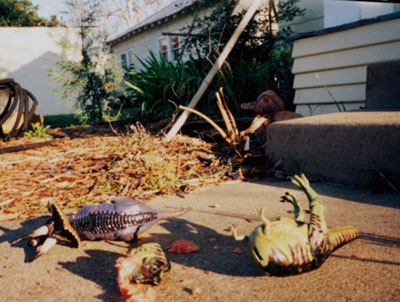
Captured in the background of a “dinosaur carnage” photo, the newly planted alligator juniper stands about 3 feet tall. For those concerned, the “meat” around the dinos is actually watermelon. No dinosaurs were injured in the making of this photo. (1999)
He was undaunted when I showed him my literally empty wallet…. “Got any money in your truck?” I went into the ashtray for coinage and came up with a dollar and ten cents in change. “Perfect!” he exclaimed, and said it was just enough for a special plant he had grown from seed, and was the last one he had. He reached down and plucked up a 2-gallon pot with a little conifer hanging out the side and announced it was an alligator juniper. He told me I would love it, and could only kill it by babying it with kindness. I had no idea it was a seedling of the trees I had seen out in Sedona years before. I took it home and planted it in my little Adoption Garden on DeVitt Avenue in Fort Worth, a few blocks from TCU.
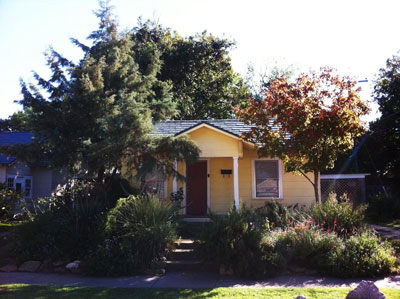
Ten years after planting, the seedling alligator juniper (left) soars past the roof at the Adoption Garden. (2011)
When I finally researched it a few days later, I sat dumbfounded at my good fortune. I watched it grow quickly — a surprise for a high-desert plant whose range includes West Texas to Arizona, and down into Old Mexico. But then again, everything seems to appreciate a little consistent drip irrigation. Within a few years, it had overtaken the top of the roof, and I had to trim the bottom limbs up to bring it in balance with the garden. I was proud to think it was probably the only one in Fort Worth at the time. Might even be true now, as I think even the Fort Worth Botanic Garden has missed this one in their collections.
Time rolled on and I took my young son to Sedona, where he was less mesmerized by the trees there than I was, but at least he was taken by the stunning landscape, colorful local characters, and four wolves a buddy of mine was raising there. He loved the fact that they ate only bison meat, so we cooked some up for dinner one night. Total carnage.
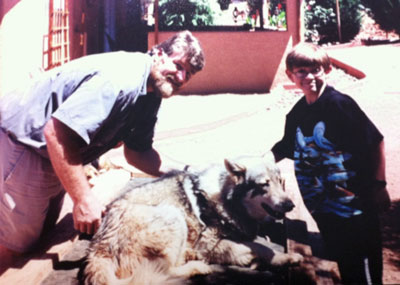
Meeting the wolves in Sedona. (2003)
Funny how planting a few trees can affect your memory. As my plants grow on into trees, maybe someone in the future will look at them and be inspired to alter their environment and create a garden of special trees. Hope they keep the beavers away from them!
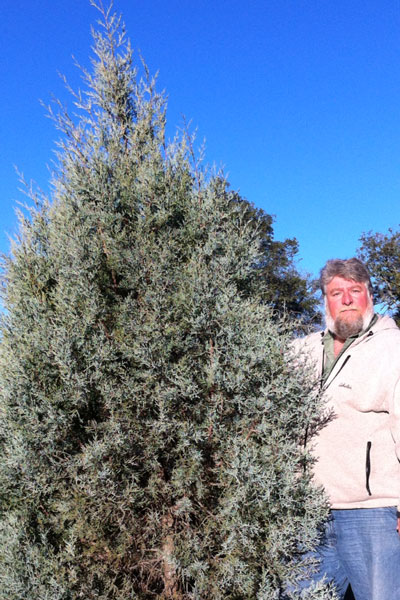
Steven, trying hard not to squint while facing the morning sun, with one of his alligator junipers.
Come out and breathe in the winter beauty of Chandor Gardens! “Pardon our mess! While most of Chandor Gardens remains as lovely as ever, extensive pond renovations and repair are underway during winter. We still encourage visitors to come out, but beware…we might put you to work!”
I can always use another road trip! Let me know if you’d like me to come out and speak to your group sometime. I’m low-maintenance, flexible, and you know I like to go just about anywhere. No city too big; no town too small. Just send me an e-mail at stevenchamblee@yahoo.com and we’ll work something out.

